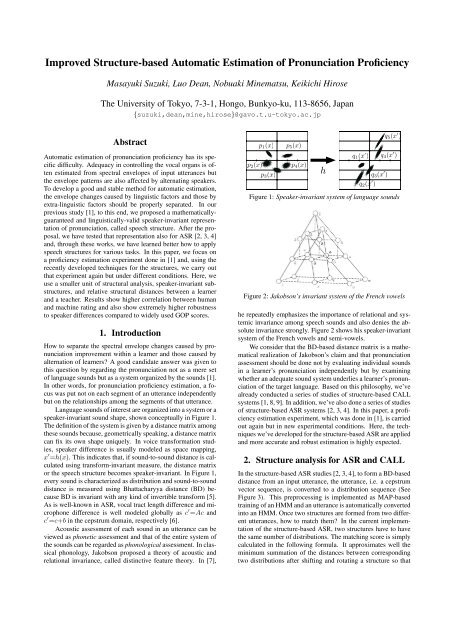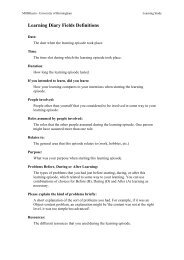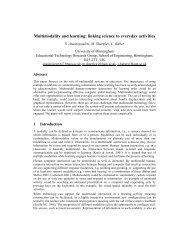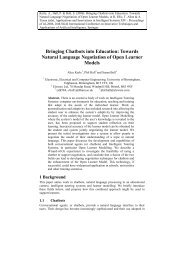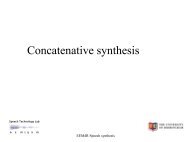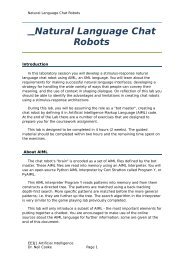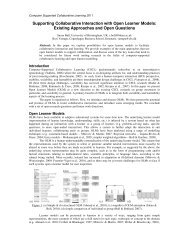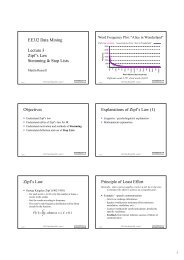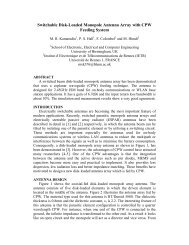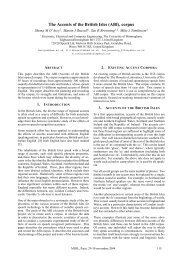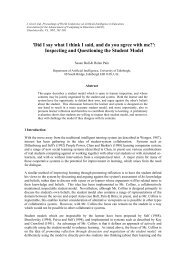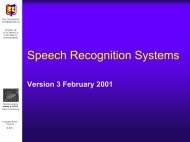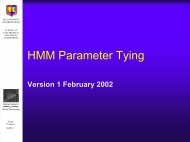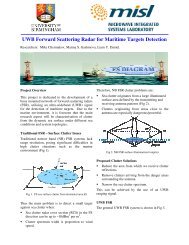Improved Structure-based Automatic Estimation of Pronunciation ...
Improved Structure-based Automatic Estimation of Pronunciation ...
Improved Structure-based Automatic Estimation of Pronunciation ...
Create successful ePaper yourself
Turn your PDF publications into a flip-book with our unique Google optimized e-Paper software.
<strong>Improved</strong> <strong>Structure</strong>-<strong>based</strong> <strong>Automatic</strong> <strong>Estimation</strong> <strong>of</strong> <strong>Pronunciation</strong> Pr<strong>of</strong>iciency<br />
Masayuki Suzuki, Luo Dean, Nobuaki Minematsu, Keikichi Hirose<br />
The University <strong>of</strong> Tokyo, 7-3-1, Hongo, Bunkyo-ku, 113-8656, Japan<br />
{suzuki,dean,mine,hirose}@gavo.t.u-tokyo.ac.jp<br />
Abstract<br />
<strong>Automatic</strong> estimation <strong>of</strong> pronunciation pr<strong>of</strong>iciency has its specific<br />
difficulty. Adequacy in controlling the vocal organs is <strong>of</strong>ten<br />
estimated from spectral envelopes <strong>of</strong> input utterances but<br />
the envelope patterns are also affected by alternating speakers.<br />
To develop a good and stable method for automatic estimation,<br />
the envelope changes caused by linguistic factors and those by<br />
extra-linguistic factors should be properly separated. In our<br />
previous study [1], to this end, we proposed a mathematicallyguaranteed<br />
and linguistically-valid speaker-invariant representation<br />
<strong>of</strong> pronunciation, called speech structure. After the proposal,<br />
we have tested that representation also for ASR [2, 3, 4]<br />
and, through these works, we have learned better how to apply<br />
speech structures for various tasks. In this paper, we focus on<br />
a pr<strong>of</strong>iciency estimation experiment done in [1] and, using the<br />
recently developed techniques for the structures, we carry out<br />
that experiment again but under different conditions. Here, we<br />
use a smaller unit <strong>of</strong> structural analysis, speaker-invariant substructures,<br />
and relative structural distances between a learner<br />
and a teacher. Results show higher correlation between human<br />
and machine rating and also show extremely higher robustness<br />
to speaker differences compared to widely used GOP scores.<br />
1. Introduction<br />
How to separate the spectral envelope changes caused by pronunciation<br />
improvement within a learner and those caused by<br />
alternation <strong>of</strong> learners A good candidate answer was given to<br />
this question by regarding the pronunciation not as a mere set<br />
<strong>of</strong> language sounds but as a system organized by the sounds [1].<br />
In other words, for pronunciation pr<strong>of</strong>iciency estimation, a focus<br />
was put not on each segment <strong>of</strong> an utterance independently<br />
but on the relationships among the segments <strong>of</strong> that utterance.<br />
Language sounds <strong>of</strong> interest are organized into a system or a<br />
speaker-invariant sound shape, shown conceptually in Figure 1.<br />
The definition <strong>of</strong> the system is given by a distance matrix among<br />
these sounds because, geometrically speaking, a distance matrix<br />
can fix its own shape uniquely. In voice transformation studies,<br />
speaker difference is usually modeled as space mapping,<br />
x ′ =h(x). This indicates that, if sound-to-sound distance is calculated<br />
using transform-invariant measure, the distance matrix<br />
or the speech structure becomes speaker-invariant. In Figure 1,<br />
every sound is characterized as distribution and sound-to-sound<br />
distance is measured using Bhattacharyya distance (BD) because<br />
BD is invariant with any kind <strong>of</strong> invertible transform [5].<br />
As is well-known in ASR, vocal tract length difference and microphone<br />
difference is well modeled globally as c ′ =Ac and<br />
c ′ =c+b in the cepstrum domain, respectively [6].<br />
Acoustic assessment <strong>of</strong> each sound in an utterance can be<br />
viewed as phonetic assessment and that <strong>of</strong> the entire system <strong>of</strong><br />
the sounds can be regarded as phonological assessment. In classical<br />
phonology, Jakobson proposed a theory <strong>of</strong> acoustic and<br />
relational invariance, called distinctive feature theory. In [7],<br />
p 2 (x)<br />
p 1 (x)<br />
p 3 (x)<br />
p 5 (x)<br />
p 4 (x)<br />
h<br />
q 1 (x ′ )<br />
q 3 (x ′ )<br />
q 2 (x ′ )<br />
q 5 (x ′ )<br />
q 4 (x ′ )<br />
Figure 1: Speaker-invariant system <strong>of</strong> language sounds<br />
Figure 2: Jakobson’s invariant system <strong>of</strong> the French vowels<br />
he repeatedly emphasizes the importance <strong>of</strong> relational and systemic<br />
invariance among speech sounds and also denies the absolute<br />
invariance strongly. Figure 2 shows his speaker-invariant<br />
system <strong>of</strong> the French vowels and semi-vowels.<br />
We consider that the BD-<strong>based</strong> distance matrix is a mathematical<br />
realization <strong>of</strong> Jakobson’s claim and that pronunciation<br />
assessment should be done not by evaluating individual sounds<br />
in a learner’s pronunciation independently but by examining<br />
whether an adequate sound system underlies a learner’s pronunciation<br />
<strong>of</strong> the target language. Based on this philosophy, we’ve<br />
already conducted a series <strong>of</strong> studies <strong>of</strong> structure-<strong>based</strong> CALL<br />
systems [1, 8, 9]. In addition, we’ve also done a series <strong>of</strong> studies<br />
<strong>of</strong> structure-<strong>based</strong> ASR systems [2, 3, 4]. In this paper, a pr<strong>of</strong>iciency<br />
estimation experiment, which was done in [1], is carried<br />
out again but in new experimental conditions. Here, the techniques<br />
we’ve developed for the structure-<strong>based</strong> ASR are applied<br />
and more accurate and robust estimation is highly expected.<br />
2. <strong>Structure</strong> analysis for ASR and CALL<br />
In the structure-<strong>based</strong> ASR studies [2, 3, 4], to form a BD-<strong>based</strong><br />
distance from an input utterance, the utterance, i.e. a cepstrum<br />
vector sequence, is converted to a distribution sequence (See<br />
Figure 3). This preprocessing is implemented as MAP-<strong>based</strong><br />
training <strong>of</strong> an HMM and an utterance is automatically converted<br />
into an HMM. Once two structures are formed from two different<br />
utterances, how to match them In the current implementation<br />
<strong>of</strong> the structure-<strong>based</strong> ASR, two structures have to have<br />
the same number <strong>of</strong> distributions. The matching score is simply<br />
calculated in the following formula. It approximates well the<br />
minimum summation <strong>of</strong> the distances between corresponding<br />
two distributions after shifting and rotating a structure so that
c 1<br />
c 1<br />
Utterances<br />
A teacher<br />
This was easy for us,,,<br />
This was easy for us,,,<br />
A student<br />
Utterances<br />
c 2<br />
c D<br />
c 4<br />
c 3<br />
c 2<br />
c D<br />
c 4<br />
c 3<br />
Feature vector<br />
sequences<br />
Feature vector<br />
sequences<br />
Figure 3: An utterance structure composed only <strong>of</strong> BDs<br />
S1<br />
Distributions<br />
(states)<br />
Distributions<br />
(states)<br />
S5<br />
T1<br />
S2<br />
T2 O<br />
T5<br />
S4 S3<br />
<strong>Structure</strong><br />
Selection <strong>of</strong> state pairs<br />
Normalization<br />
<strong>Structure</strong><br />
T4<br />
Figure 4: <strong>Structure</strong> comparison through shift & rotation<br />
the two structures are overlapped the best (See Figure 4).<br />
T3<br />
s<br />
1 X<br />
D 1(S, T ) = (S ij − T ij)<br />
M<br />
2 , (1)<br />
where S and T are two distance matrices whose elements are<br />
calculated as √ BD. M is the number <strong>of</strong> distributions. In the<br />
cepstrum domain, shift and rotation <strong>of</strong> a structure correspond<br />
to cancellation <strong>of</strong> differences in microphone and in vocal tract<br />
length, respectively [10]. This indicates that the structure-<strong>based</strong><br />
ASR gives matching scores after global adaptation without explicit<br />
adaptation. This is why the structure-<strong>based</strong> ASR is extremely<br />
robust to microphone and speaker differences [2, 3, 4].<br />
In the structure-<strong>based</strong> CALL studies [1, 8, 9], a student’s<br />
structure S and a teacher’s structure T are extracted from their<br />
plural utterances. In [1], from about 60 sentence utterances, a<br />
structure <strong>of</strong> the entire phonemes is formed for a student while,<br />
in [8, 9], a vowel structure is extracted from eleven word utterances<br />
containing the eleven American English monophthongs.<br />
In [1], through structural comparison between each student <strong>of</strong><br />
a Japanese-English database [11] and a specific teacher, pronunciation<br />
pr<strong>of</strong>iciency is automatically estimated. The obtained<br />
scores are compared to the pr<strong>of</strong>iciency scores given by five native<br />
teachers <strong>of</strong> American English and high correlation is found.<br />
In [8, 9], D 1 (S, T ) is decomposed into vowel pairs and, through<br />
pairwise structural analysis, diagnostic instructions on which<br />
vowel to correct at first are provided for each student.<br />
i
Table 1: Condition for the acoustic analysis<br />
sampling 16bit / 16kHz<br />
windows 25ms length and 10ms shift<br />
training data about 75 sentences per speaker<br />
parameters MFCC + ∆ + ∆Power (25dim.)<br />
HMMs speaker-dependent, context-independent, and<br />
1-mixture monophones with diagonal matrix<br />
topology 5 states and 3 distributions per HMM<br />
monophones aa,ae,ah,ao,aw,ax,axr,ay,b,ch,d,dh,eh,er,ey,<br />
f,g,hh,ih,iy,j,jh,k,l,m,n,ng,ow,oy,p,r,s,sh,t,th,<br />
uh,uw,v,w,y,z,zh,sil<br />
the TIMIT sentences and students <strong>of</strong> different sets read different<br />
sentences. The eight sets cover the TIMIT sentences completely.<br />
Pr<strong>of</strong>iciency scores are also provided for all the students,<br />
which were manually given by five native teachers <strong>of</strong> American<br />
English with good knowledge <strong>of</strong> phonetics and Japanese English.<br />
In addition to speech and label data <strong>of</strong> Japanese English,<br />
in the corpus, the utterances <strong>of</strong> the same sentences read by 20<br />
native speakers <strong>of</strong> General American English (GA) are also included.<br />
18 <strong>of</strong> them read a half <strong>of</strong> the entire sentences and two<br />
read all the sentences. In this paper, a male speaker (M08) <strong>of</strong><br />
the two is used as a teacher commonly for all the 200 students.<br />
3.3. <strong>Structure</strong>-<strong>based</strong> analysis and GOP-<strong>based</strong> analysis<br />
Table 1 shows the acoustic analysis conditions and the number<br />
<strong>of</strong> AE monophones is 43. From the students, 200 sets <strong>of</strong> mohophone<br />
HMMs are trained. From the single teacher, eight sets<br />
<strong>of</strong> HMMs are trained, each corresponding to a sentence set in<br />
ERJ. From all the sets <strong>of</strong> HMMs, 208 129×129(=43×3) BD<strong>based</strong><br />
distance matrices are formed in total. Using the students<br />
<strong>of</strong> all the sets but set-6, the optimal definition <strong>of</strong> state-<strong>based</strong><br />
sub-structures is estimated. Selection <strong>of</strong> state pairs is incrementally<br />
determined to maximize the correlation between machine<br />
rating and human rating. Here, −D 1 or −D 2 is used as machine<br />
scores and they are calculated by matching a student’s<br />
sub-structure and the sub-structure <strong>of</strong> the corresponding sentence<br />
set <strong>of</strong> the teacher. Following the obtained optimal definition<br />
<strong>of</strong> sub-structures, those <strong>of</strong> the 26 students <strong>of</strong> set-6 are used<br />
as open data and compared to the teacher’s sub-structure. Then,<br />
correlation between machine and human is calculated.<br />
For comparison, the pronunciation pr<strong>of</strong>iciency is estimated<br />
as GOP (Goodness Of <strong>Pronunciation</strong>) scores, i.e. posterior<br />
probabilities <strong>of</strong> the intended phonemes given input utterances.<br />
GOP (o 1, ..., o T , p 1, ..., p N )<br />
= P (p 1, ..., p N |o 1, ..., o T )<br />
≈ 1 NX<br />
j<br />
1 P (o p i<br />
ff<br />
|p i)<br />
log<br />
, (3)<br />
N D pi max q∈Q P (o p i |q)<br />
i=1<br />
where T is the total length <strong>of</strong> given observation sequences and<br />
N is the number <strong>of</strong> the intended phonemes. o p i<br />
is the speech<br />
segment obtained for p i through forced alignment and D pi is<br />
its duration. {o p 1<br />
,...,o p N<br />
} correspond to {o 1,...,o T }. Q is the<br />
inventory <strong>of</strong> phonemes. The GOP was originally proposed in<br />
[12] and is widely accepted as pronunciation pr<strong>of</strong>iciency. Since<br />
GOP is probability ratio, it internally has a function <strong>of</strong> canceling<br />
acoustic mismatch between teachers’ HMMs and a learner’s<br />
utterance. In this paper, nine sets <strong>of</strong> HMMs are prepared to calculate<br />
the GOP. Eight sets are from eight sentence sets <strong>of</strong> the<br />
common teacher (M08). The other set is trained with all the<br />
utterances <strong>of</strong> the 20 native speakers <strong>of</strong> American English.<br />
Correlation coefficients<br />
1<br />
0.8<br />
0.6<br />
0.4<br />
0.2<br />
Relative differences<br />
Normalization in size<br />
No normalization<br />
0<br />
0 100 200 300 400 500 600 700 800 900<br />
Number <strong>of</strong> selected phoneme pairs<br />
Figure 6: Correlations with phoneme-<strong>based</strong> structure analysis<br />
Correlation coefficients<br />
1<br />
0.8<br />
0.6<br />
0.4<br />
0.2<br />
Relative differences<br />
Normalization in size<br />
No normalization<br />
0<br />
0 1000 2000 3000 4000 5000 6000 7000 8000<br />
Number <strong>of</strong> selected state pairs<br />
Figure 7: Correlations with state-<strong>based</strong> structure analysis<br />
Correlation coefficients<br />
1<br />
0.8<br />
0.6<br />
0.4<br />
0.2<br />
All the 20 teachers<br />
A single teacher<br />
0<br />
0 5 10 15 20 25 30 35 40 45<br />
Number <strong>of</strong> selected phonemes<br />
Figure 8: Correlations with GOP analysis<br />
3.4. Results <strong>of</strong> pronunciation pr<strong>of</strong>iciency estimation<br />
Results <strong>of</strong> pr<strong>of</strong>iciency estimation by phoneme-<strong>based</strong> structure<br />
analysis are shown in Figure 6. X-axis represents the number<br />
<strong>of</strong> selected phoneme pairs. The maximum is 43 C 2 =903.<br />
Colors indicate differences in normalization methods. The red<br />
curve is obtained using relative and structural differences <strong>of</strong><br />
Equation (2) and the green one is drawn by normalizing the size<br />
<strong>of</strong> sub-structures. The blue curve indicates no normalization.<br />
When we used finer units <strong>of</strong> structure analysis, state-<strong>based</strong><br />
structure analysis, as we expected, higher correlations were obtained,<br />
shown in Figure 7. Here, X-axis is the number <strong>of</strong> selected<br />
state pairs and its maximum is 43×3 C 2 =8,256. Similarly<br />
to Figure 6, colors indicate differences in normalization.<br />
Looking at both the figures, we can find easily that feature<br />
selection works effectively to improve the performance and that<br />
finer units <strong>of</strong> structure analysis, i.e. state-<strong>based</strong> sub-structures,<br />
are also beneficial. Checking each <strong>of</strong> them, we can find that<br />
the effect <strong>of</strong> normalization somewhat differs between them. In
Correlation coefficients<br />
1<br />
0.8<br />
0.6<br />
0.4<br />
0.2<br />
0<br />
A single teacher’s structure<br />
20 teachers’ HMMs (GOP)<br />
-0.2<br />
-0.4 -0.3 -0.2 -0.1 0 0.1 0.2 0.3 0.4<br />
Warping parameter®<br />
Figure 9: Correlations with warped utterances<br />
the phoneme-<strong>based</strong> structure analysis, the size-<strong>based</strong> normalization<br />
works poorly and, in the state-<strong>based</strong> structure analysis,<br />
the effect <strong>of</strong> Equation (2) is significant. In Figure 7, with<br />
Equation (2), the highest correlation (0.84) is obtained in the<br />
case <strong>of</strong> 86 selected state pairs. Although this number is very<br />
small, the 172(=86×2) states cover 41 phonemes out <strong>of</strong> 43.<br />
Figure 8 shows the results <strong>of</strong> estimating the GOP scores for<br />
two cases. One is using the HMMs <strong>of</strong> the common teacher and<br />
the other is using those <strong>of</strong> all the AE speakers. As in structure<br />
analysis, we carried out incremental phoneme selection to realize<br />
discriminative comparison. This selection is also effective<br />
here and the highest correlation (0.87) is found at the number <strong>of</strong><br />
27. The performance difference between two sets <strong>of</strong> HMMs can<br />
be interpreted as follows. Although GOP has an internal function<br />
<strong>of</strong> mismatch cancelation, this function works only when<br />
forced alignment performs well. In some cases, this condition<br />
is less satisfied. Then, the GOP scores <strong>of</strong> the common teacher<br />
shows less correlations than those <strong>of</strong> all the teachers.<br />
4. Robustness <strong>of</strong> the proposed method with<br />
respect to speaker differences<br />
4.1. Urgent requirement for extremely robust technologies<br />
The Japanese government decided to introduce lessons for oral<br />
English communication to every primary school from 2011 but<br />
we don’t have a sufficient number <strong>of</strong> English teachers. The government<br />
expects class teachers, many <strong>of</strong> whom did not receive<br />
a good education for teaching English, to play an important role<br />
in the lessons. In this situation, we consider that some technical<br />
solutions will be introduced to classrooms. <strong>Automatic</strong> estimation<br />
<strong>of</strong> pronunciation pr<strong>of</strong>iciency is one <strong>of</strong> the key technologies<br />
and it requires high robustness because the pronunciations <strong>of</strong><br />
adult teachers and young children have to be treated properly.<br />
4.2. Robustness <strong>of</strong> the structures and the GOP<br />
Figure 9 shows the results <strong>of</strong> pr<strong>of</strong>iciency estimation using the<br />
structures (the common teacher) and the GOP (all the teachers).<br />
In this case, by using frequency warping techniques, all the input<br />
utterances <strong>of</strong> set-6 were transformed as if they had been<br />
generated by speakers <strong>of</strong> various vocal tract lengths. X-axis<br />
means warping parameter α and, with α=−0.4/+0.4, the vocal<br />
tract length is doubled/halved. Two speech segments warped<br />
from the same segment with α=+0.3 and α=−0.3 are shown.<br />
Frequency warping resulted in a drastic acoustic modification.<br />
In spite <strong>of</strong> this large change, Figure 9 shows the extreme robustness<br />
<strong>of</strong> the structures but it also shows the extreme weakness <strong>of</strong><br />
the GOP. We can say that even a single teacher’s structure can<br />
be used directly and effectively for any student <strong>of</strong> any size.<br />
5. Discussions and conclusions<br />
In this paper, the improvement <strong>of</strong> structure-<strong>based</strong> pr<strong>of</strong>iciency<br />
estimation is realized and its high robustness to speaker variability<br />
is experimentally verified. Further, the weakness <strong>of</strong> GOP<br />
is also made clear. As GOP is basically a posterior probability,<br />
it internally has a function <strong>of</strong> canceling acoustic mismatch<br />
between HMMs and learners. But this function only works<br />
when forced alignment (numerator <strong>of</strong> Equation (3)) and continuous<br />
phoneme recognition (denominator <strong>of</strong> Equation (3)) perform<br />
properly. With a large acoustic mismatch, however, the<br />
two processes inevitably fail. To avoid this, teachers’ models<br />
(HMMs) are <strong>of</strong>ten adapted to learners. If one wants to prepare<br />
the most adequate models for a specific learner, one has to build<br />
the models trained with that learner who would pronounce the<br />
target language correctly. It is ideal that a student and his/her<br />
teacher have the same voice quality because <strong>of</strong> no mismatch.<br />
This technical requirement leads us to consider that GOP<br />
should stand for, not Goodness Of <strong>Pronunciation</strong>, but Goodness<br />
Of imPersonation, which quantifies how well a learner can impersonate<br />
the model speaker [13]. But learning to pronounce is<br />
not learning to impersonate at all. No male student tries to produce<br />
female voices when asked to repeat what a female teacher<br />
said. No young child produces deep voices to repeat what a tall<br />
male teacher said. As Jakobson claimed, we consider that they<br />
extract a speaker-invariant sound system underling a given utternace<br />
and try to reproduce that system orally. But inevitable<br />
differences in size and shape <strong>of</strong> the vocal organs between a<br />
learner and a teacher have to cause acoustic differences between<br />
their utterances. Computer-Aided Language Learning (CALL)<br />
or Computer-Aided Impersonation Learning (CAIL), which is<br />
needed for classrooms We believe that the answer is obvious.<br />
6. References<br />
[1] N. Minematsu, “<strong>Pronunciation</strong> assessment <strong>based</strong> upon the phonological<br />
distortions observed in language learners’ utterances,”<br />
Proc. INTERSPEECH, pp.1669–1672, 2004.<br />
[2] Y. Qiao et al., “Random discriminant structure analysis for continous<br />
Japanese vowel recognition,” Proc. ASRU, pp.576–581,<br />
2007.<br />
[3] S. Asakawa et al., “Multi-stream parameterization for structural<br />
speech recognition,” Proc. ICASSP, pp.4097–4100, 2008.<br />
[4] N. Minematsu et al., “Implementation <strong>of</strong> robust speech recognition<br />
by simulating infants’ speech perception <strong>based</strong> on the invariant<br />
sound shape embedded in utterances,” Proc. SPECOM, 2009.<br />
[5] Y. Qiao et al., “f-divergence is a generalized invariant measure<br />
between distributions,” Proc. INTERSPEECH, pp.1349–1452,<br />
2008.<br />
[6] M. Pitz et al., “Vocal tract normalization equals linear transformation<br />
in cepstral space,” IEEE Trans. Speech and Audio Processing,<br />
13, 5, pp.930–944, 2005.<br />
[7] R. Jakobson et al., The sound shape <strong>of</strong> language, Mouton De<br />
Gruyter, 1987<br />
[8] N. Minematsu et al., “Structural representation <strong>of</strong> the pronunciation<br />
and its use for CALL,” Proc. SLT, pp.126–129, 2006.<br />
[9] N. Minematsu et al., “Structural representation <strong>of</strong> the pronunciation<br />
and its use for classifying Japanese learners <strong>of</strong> English,” Proc.<br />
SLaTE, CD-ROM, 2007.<br />
[10] D. Saito et al., “Directional dependency <strong>of</strong> cepstrum on vocal tract<br />
length,” Proc. ICASSP, pp.4485–4488, 2008.<br />
[11] N. Minematsu, et al., “Development <strong>of</strong> English speech database<br />
read by Japanese to support CALL research,” Proc. ICA, pp.577–<br />
560, 2004.<br />
[12] S. M. Witt et al., “Phone-level pronunciation scoring and assessment<br />
for interactive language learning,” Speech Communication,<br />
30, pp.95–108, 2000.<br />
[13] N. Minematsu, “Are learners myna birds to the averaged distributions<br />
<strong>of</strong> native speakers –a note <strong>of</strong> warning from a serious speech<br />
engineer–,” Proc. SLaTE, CD-ROM, 2007.


